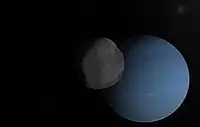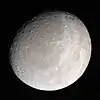ပရိုသီးစ် (ဂြိုဟ်ရံလ)
ပရိုသီးစ် (အင်္ဂလိပ်: Proteus) သည် နက်ပကျွန်းဂြိုဟ်၏ ဒုတိယအကြီးဆုံး ဂြိုဟ်ရံလဖြစ်ပြီး အကြီးဆုံး အတွင်းပိုင်းလဖြစ်သည်။ ၁၉၈၉ ခုနှစ်တွင် ဗွိုင်ယေဂျာ ၂ မှ ရှာဖွေတွေ့ရှိခဲ့ပြီး ဂရိဒဏ္ဍာရီလာ ပင်လယ်နတ်ဘုရား Proteus ကိုအစွဲပြု၍ မှည့်ခေါ်ခြင်းဖြစ်သည်။ ရေခဲကိုယ်ထည် ၄၀၀ ကီလိုမီတာဖြင့် လွှမ်းခြုံထားသော်လည်း ပရိုသီးစ်၏ ပုံစံသည် လုံးဝိုင်းသည့်ပုံစံမှ အနည်းငယ် သွေဖယ်သည်။ သဘာဝအရောင်မှာ နက်မှောင်လျက်ရှိပြီး မျက်နှာပြင်၌ ချိုင့်ဝှမ်းများလည်း တည်ရှိသည်။ မိခင်ဂြိုဟ် လှည့်ပတ်သည့် လားရာအတိုင်း လှည့်ပတ်သောကြောင့် ပရိုသီးစ်၏ မျက်နှာပြင်တစ်ခြမ်းသည် နက်ပကျွန်းဂြိုဟ်ဘက်သို့ အစဉ်မျက်နှာမူလျက် ရှိသည်။
.jpg.webp) ဗွိုင်ယေဂျာ ၂ image (1989) | |
| ရှာဖွေတွေ့ရှိခြင်း | |
|---|---|
| ရှာဖွေတွေ့ရှိခဲ့သူ | ဗွိုင်ယေဂျာ ၂ စတီဖင် ပီ ဆင်းနော့ |
| ရှာဖွေတွေ့ရှိသည့် ရက်စွဲ | June 16, 1989 |
| ပါဝင်အရာဝတ္ထုများ | Protean |
| ပတ်လမ်း ဂုဏ်အင်များ[1] | |
| Epoch 18 August 1989 | |
| Periapsis | 117584±10 km |
| Apoapsis | 117709±10 km |
ဆီမီး မေဂျာ ဝင်ရိုး | 117647±1 km (4.75 RN) |
| ပတ်လမ်း ဗဟိုကျမှု | 0.00053±0.00009 |
ပတ်လမ်း ကာလ | 1.12231477±0.00000002 d |
ပျမ်းမျှ ပတ်နှုန်း | 7.623 km/s |
| ပတ်လမ်း တိမ်းစောင်းမှု | 0.524° (to Neptune equator) 0.026°±0.007° (to local Laplace plane) |
| ဂြိုဟ်ရံလများ | နက်ပကျွန်းဂြိုဟ် |
| ရုပ်ပိုင်းဆိုင်ရာ ဂုဏ်အင်များ | |
| ဒိုင်မင်းရှင်း | 424 × 390 × 396 km[2][lower-alpha 1] |
ပျမ်းမျှ အချင်းဝက် | 210±7 km[5] |
| ထုထည် | (3.4±0.4)×107 km3[2] |
| အရွယ်အစား | 4.4×1019 kg[lower-alpha 2] |
ပျမ်းမျှ သိပ်သည်းဆ | ≈ 1.3 g/cm³ (estimate)[5] |
မျက်နှာပြင် ဒြပ်ဆွဲအား | 0.07 m/s2[lower-alpha 3] |
လွတ်မြောက်အလျင် | 0.17 km/s[lower-alpha 4] |
လှည့်ပတ်ကာလ | synchronous[2] |
ဝင်ရိုးတိမ်းစောင်းမှု | zero[2] |
| Albedo | 0.096[5][6] |
| အပူချိန် | ≈ 51 K mean (estimate) |
မြင်သာသော အရွယ်အစား | 19.7[5] |
ဓာတ်ပုံ
 A simulated view of Proteus orbiting Neptune
A simulated view of Proteus orbiting Neptune.jpg.webp) Map of Proteus
Map of Proteus The only color image taken of Proteus, showing its pinkish-red color
The only color image taken of Proteus, showing its pinkish-red color
မှတ်စု
- In the earlier papers slightly different dimensions were reported. Thomas and Veverka in 1991 reported 440×416×404 km.[2][3] Croft in 1992 reported 430×424×410 km.[4] The difference is caused by the use of different sets of images and by the fact that the shape of Proteus is not described well by a triaxial ellipsoid.[2]
- The mass was calculated by multiplying the volume from Stooke (1994)[2] by the assumed density of 1,300 kg/m3. If one uses slightly larger dimensions from the earlier papers the mass will increase to 5×10၁၉ kg.[5]
- Surface gravity derived from the mass m, the gravitational constant G and the radius r: Gm/r2.
- Escape velocity derived from the mass m, the gravitational constant G and the radius r: √2Gm/r.
ကိုးကား
- "The orbits of the inner Neptunian satellites from Voyager, Earthbased, and Hubble Space Telescope observations" (2004). Astronomical Journal 128 (3): 1412–1417. doi:. Bibcode: 2004AJ....128.1412J.
- Stooke, Philip J. (1994). "The surfaces of Larissa and Proteus". Earth, Moon, and Planets 65 (1): 31–54. doi:. Bibcode: 1994EM&P...65...31S.
- Williams၊ Dr. David R. (2008-01-22)။ Neptunian Satellite Fact Sheet။ NASA (National Space Science Data Center)။ 2008-12-12 တွင် ပြန်စစ်ပြီး။
- "Proteus: Geology, shape, and catastrophic destruction" (1992). Icarus 99 (2): 402–408. doi:. Bibcode: 1992Icar...99..402C.
- Planetary Satellite Physical Parameters။ JPL (Solar System Dynamics) (2010-10-18)။ 2011-10-11 တွင် ပြန်စစ်ပြီး။
- Karkoschka, Erich (2003). "Sizes, shapes, and albedos of the inner satellites of Neptune". Icarus 162 (2): 400–407. doi:. Bibcode: 2003Icar..162..400K.
This article is issued from Wikipedia. The text is licensed under Creative Commons - Attribution - Sharealike. Additional terms may apply for the media files.
